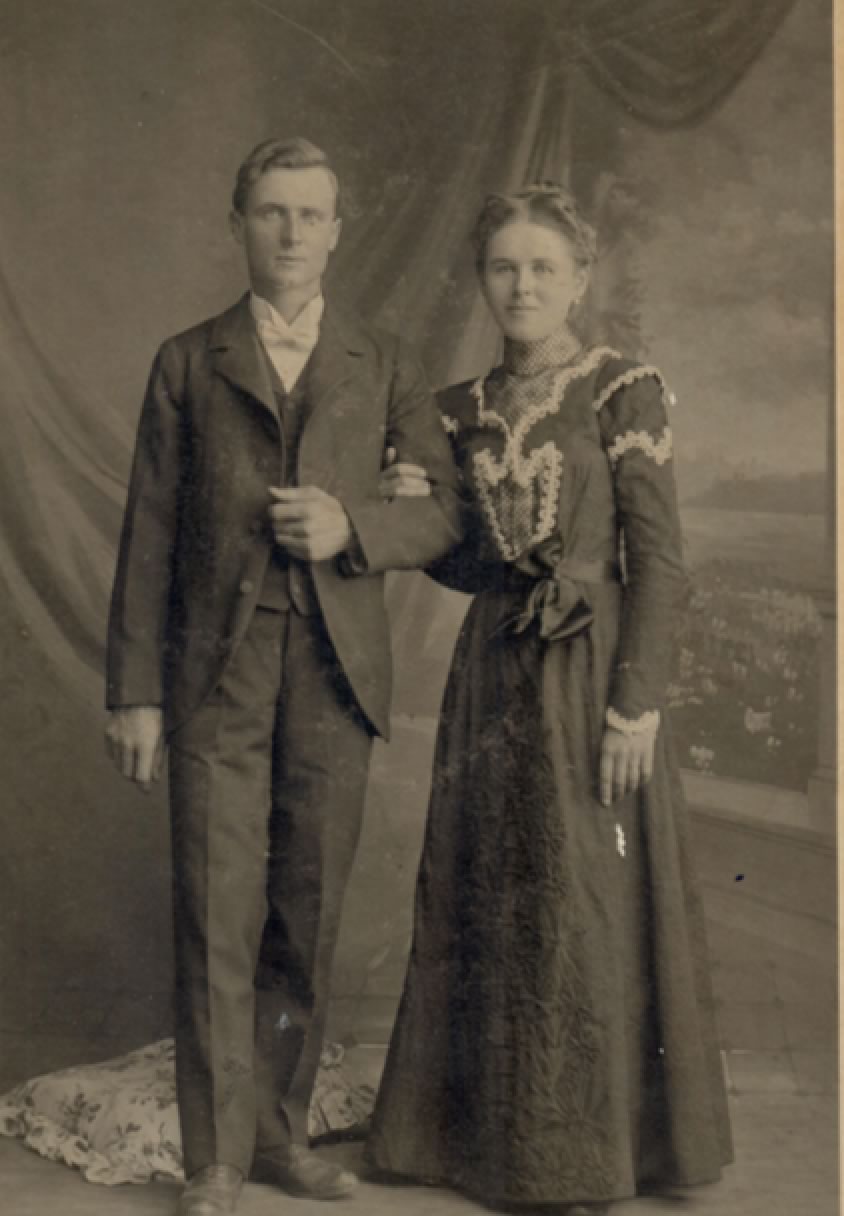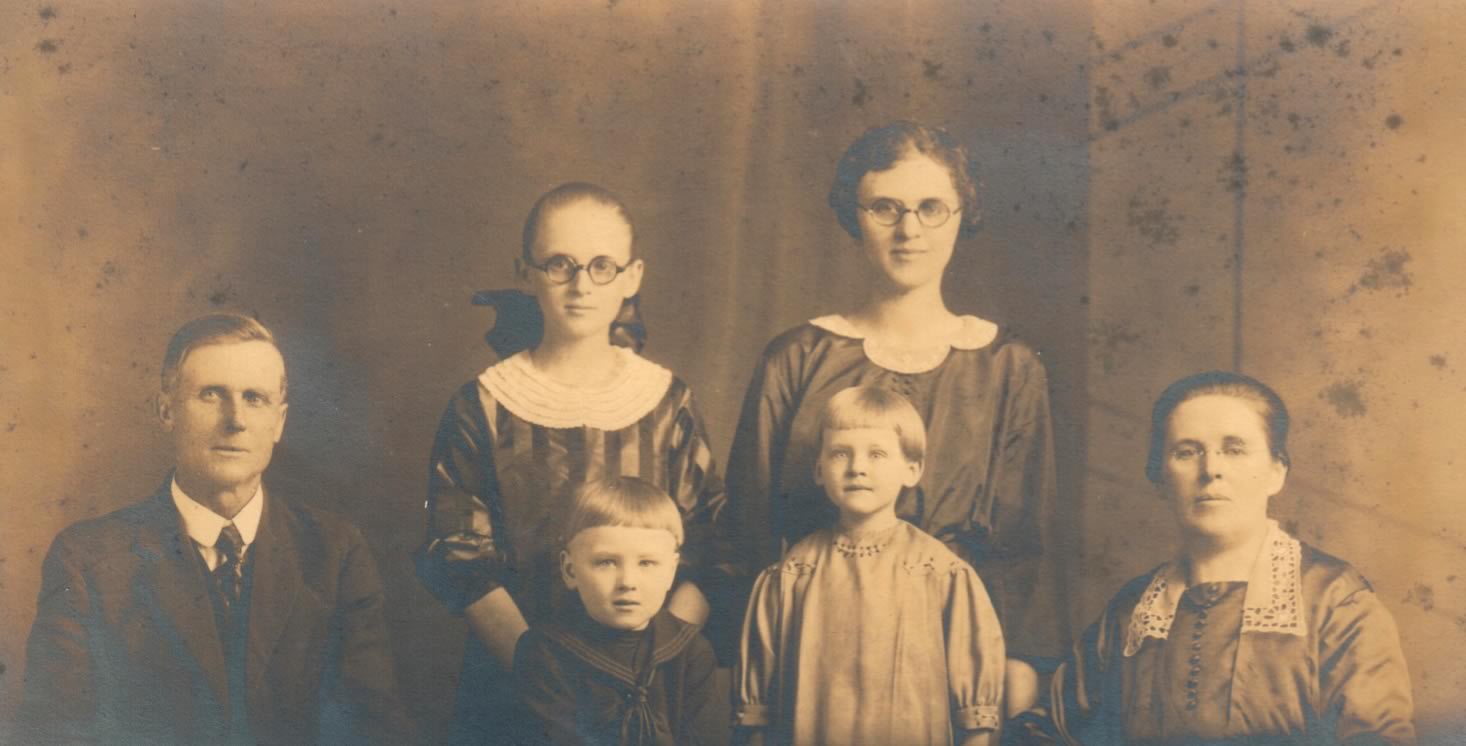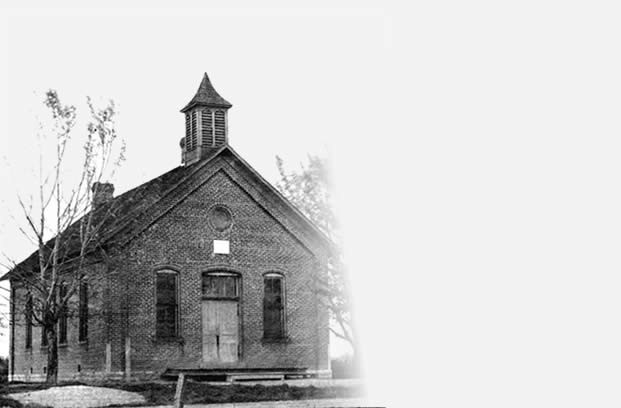William Hoelscher Recalls Hearing Grandparents Walked 30 Miles in Germany to See Display of American Grown Indian Corn Before They Emigrated to U. S.; the Land of Opportunity.

William L. Hoelscher and Anna Matilda Bierbaum wedding May 17, 1900
People came to America from Germany for a variety of reasons. Back in 1837 a young married couple, Mr. and Mrs. Henry Hoelscher from Ladbergen, Germany, walked a distance of 30 miles for no other reason than to see a display of American corn. They were already vitally interested in America.
But the display of American grown Indian corn that they saw that day was—not the straw, but the CORN that broke the camel’s back. The camel in this case was the last remaining stronghold of doubt regarding the desirability of migrating to America. So to America they came the very next year, 1838.
By exercising every conceivable economy they managed to have two dollars left when they reached Cincinnati. They somehow got to the New Knoxville community where they took up residence. Mr. Hoelscher now worked on the Miami Erie Canal for two years after which he moved to what is today known as the Ernst Hoelscher farm east of New Knoxville where Emil Hoelscher now lives. At that time they had never seen a plow but they somehow managed to clear and to cultivate four acres of ground on which they made their home. The first ten years were so strenuous and backbreaking that if they had had the money, they would have gone back to Germany. But the tide turned, and after they actually had enough money to go back, they chose to stay.
Four children were born to the Hoelschers, one of which was the late Ernst Hoelscher. The latter married Adeline Wellman who was one of a family of 18 children. They stayed on the Hoelscher farm where 8 children were born to them, 6 of whom grew to maturity. Among them was the subject of this sketch, William L. Hoelscher.
William Hoelscher attended what was known as the Hoelscher School. He related that the first two months of his school life were spent under a German instructor. Mr. Hoelscher knew no English, but the instructor didn’t either. He related that the teacher had been so nearsighted that he was unable to distinguish, or clearly to see the pupils in the back part of the room. In consequence some of the older boys sometimes carried on little romances with the girls, slipping in the desks beside them. Some even jumped through the window and went fishing, all unbeknown to the teacher. His next instructor was the late Dr. Fledderjohann.
At that time “educational clubs” flourished, spelling bees attracted a large attendance, and the young people would travel for miles by sled or buggy to attend them. There were also dramatic clubs, literary societies which staged debates and at which competing quartets would sing. Mr. Hoelscher says he will never forget the Hoelscher brass quartet of which he was a member.
“When I was 3 years old my father built a fish pond. They had carp sent in with which they stocked the pond. But one severe winter the pond froze over solidly, and there was no hole in the ice, and so all the carp died. There must have been a wagon-box-full of them. After that all kinds of fish, including catfish, sunfish, and suckers were put in the pond. Those were the good old days. But after about 20 years the muskrats had so completely tunneled the bank that one night not only the water but also the fish were all drained from the pond. That was the end of the fish pond.”
While they had the fish pond the Hoelscher boys wanted a boat. But Grandfather objected, so they secretly built it on the second floor of the corn crib. Their boating as well as their birthday clothes swim- ming was done under cover of darkness. If Grandpa heard the commotion he must have marveled at how the fish were splashing about in the pond.
Mr. Hoelscher “went to catechism” two months each summer for three years. On Sunday afternoons all the neighborhood children would start their weekly pilgrimage to Sunday School at New Knoxville. Sometimes it was so muddy that they wore their mud boots. One particular Sunday afternoon they were caught in a heavy downpour and so a dozen or more of them took refuge in a barn for two hours. An annual highlight was the Fourth of July picnic held in the Fred Haberkamp woods. “Then we had a good time. The old folks would pitch horseshoe, the ladies visited with each other, and we boys shot firecrackers, had swing rides and spent what little money we had.”
When he was 20 years old he and his brother George and cousin Henry Hoelscher decided to go to Iowa. They left early in March, and when they got there it was 18 below zero. “The second week that we were there we went rabbit hunting. I nearly froze to death. I couldn’t walk fast enough to keep warm.” He worked for a farmer 12 miles from Garner, Iowa. One day in August the farmer remarked that it looked as if they would have the best crops that they ever had. A week later they had a hail storm. “It hailed so hard that 4 feet of hail was piled up against the side of the barn. There wasn’t enough feed left on the 360 acres to feed one cow. On that same day the farmer and I saw a tornado pass within 40 rods of the barn. Thereafter I worked for another farmer until December, after which all three of us went back to New Knoxville.”
Mr. Hoelscher worked at the carpenter trade for about 6 years during which time he helped con- struct exactly 35 derricks while the oil boom was at its height. When he was 21 years old he met Miss Matilda Bierbaum while on his way home from a Sunday School teachers’ meeting. He took her home that night, and it seems the teachers’ meeting took on new interest for him. The third or fourth time he took her home he asked her—“How would you like to go to such-and-such a farm with me?” She must have caught on, for she asked “When?” “About a year from now,” he answered. She “would be glad to”, and did. That’s how they “got engaged”, their marriage following on May 17, 1900, at the Bierbaum home with about 85 guests present. Six months later they went on their honeymoon, to relatives in Cincinnati. Now they went to live on that farm where Mr. Hoelscher had meanwhile built a home.
“Farming then wasn’t what it is today”, Mr. Hoelscher said. “I farmed 22 years without a tractor and didn’t have an automobile until 1915. Farming the old way was hard, hard work, but we were always satisfied and content”. On March 1, 1939, Mrs. Hoelscher died. Several years later he turned over his farm to his son Myron who continues to operate it. He is 73 years old, retired, but always finds something to do at the farm of his son-in-law and daughter, Mr. and Mrs. Leonard Clausing 1 1⁄2 miles north of New Knoxville. Whenever the first nice days peek out in the spring you can often find him along the banks of the lake, fishing. This year he caught around 300 fish which his children and grandchildren enjoy eating, but not nearly as much as he enjoys catching them. Evenings, in season, you will find him at the park-ball and baseball games. He doesn’t miss any games if he can help it. He also enjoys visiting with people and especially those with whom he can talk over old times.
Two reminiscences told by Mr. Hoelscher are of interest. As a lad he went mushroom hunting one day. He didn’t find any mushrooms, but while looking for them he happened to glance to one side, and there were two huge snakes, each holding up its head about a foot high and flicking their tongues at him. Chills went down his back, and he forgot all about mushrooms. He backed away and found a club with which he dispatched them both. He reported them as being the largest snakes that he had ever seen outside of a zoo. Both were over 6 feet long and really heavy. The other story had to do with a Halloween prank. A group of boys went into a neighbor’s woods on Halloween night. There was a pile of freshly split fence rails, just waiting for boys bent on something or other. So the gang decided to make what would look like a railroad track from one end of the woods to other, the fence rails serving as the rails. The neighbor may or may not have been mystified by what he saw the next morning, and he may or may not have suspected the perpetrators. But he needed a hired hand on his farm. A certain young man was employed. It turned out to be the very lad who had been ring leader in the fence-rail-track construction gang. When the lad started working for his neighbor his first job was to BUILD A RAIL FENCE, ALONE, with the very rails that he helped scatter through the woods. He had to pick them up, carry or drag them where needed, and construct the fence himself. The neighbor never mentioned a word about the fence- rail track. We have a sneaking suspicion he must have gotten a good laugh out of watching the lad at work. When I smiled Mr. Hoelscher said—“But that lad WAS NOT ME!”
Another anecdote related to his grandfather (who with his bride walked 30 miles to see the display of American-grown corn). At Ladbergen, Germany, a group of young people decided to perpetrate a little hocus-pocus. They took apart a full sized farm wagon and, one by one, carried the parts up on the roof of a man’s house and there put it together again, all under cover of darkness. Then with baskets and in their aprons the girls carried manure and completely loaded up the wagon. All pledged absolute secrecy and no one broke the pledge. The next morning not only the owner, but the entire village was mystified at the sight of a big farm wagon, fully loaded with manure standing atop a man’s house. “My grandfather and grandmother were both among the young folks who helped with that!”, Mr. Hoelscher said.
The William Hoelscher children are Irene (Mrs. Gustave) Kuck of R.R. 1, New Bremen; Lenora (Mrs. Leonard) Clausing, with whom he makes his home at R. R. 3, St. Marys; Myron (and Virgina) Hoelscher, R. R. 3, St. Marys; Miss Elody Hoelscher, who expects to graduate from The Ohio State University in accountancy this month. There are three grandchildren.

Mr. and Mrs William L. Hoelscher with their family circa 1923 Front: Myron and Elody Back: Lenora and Irene ( l to r)

Mr. Hoelscher in 1949 with his grandsons, Don Clausing, Doug Hoelscher, and Larry Clausing
This article is from an interview with my grandfather, William L. Hoelscher (1877-1953), which was published in the Evening Leader in 1950. His grandparents, who came from Germany, were Herman Heinrich Hoelscher (aka Henry) and his wife Elizabeth Anna Marie Niemeyer Hoelscher, and they settled at what is now 8842 State Route 219, New Knoxville. The Botkins and St. Marys addresses mentioned at the end of article are today all New Knoxville addresses. The farm where William Hoelscher settled after his marriage in 1900 is located at 11075 Bay Rd.
Doug Hoelscher


